Understanding Industry-Specific Risks: Different industries may exhibit varying levels of risk factors for chronic diseases. It's essential to be aware of these variations to address specific challenges effectively.
National Trends in Health and Wellbeing: Since 2007–08, there have been positive changes in health and wellbeing nationally. Fewer people are smoking or consuming harmful levels of alcohol, and more individuals are engaging in physical activity. However, challenges persist, with two-thirds of the population being overweight or obese, and only 50 percent meeting the recommended fruit and vegetable intake.
Industry-Specific Risk Factors: The table below provides a summary of the prevalence of modifiable lifestyle risk factors across different industries. This information aims to highlight areas that may require targeted interventions to promote healthier lifestyles among workers.
Table: Modifiable Lifestyle Risk Factors Across Industries (%)
| Analysis of persons 18+ years | Current smoker | Inadequate fruit and vegetable intake | Physical inactivity | Over-weight or obese | Increased high risk waist circumference | Alcohol increased lifetime risk | Poor mental health |
|---|---|---|---|---|---|---|---|
| National 2007-08 | 22 | 49 | 71 | 59 | 55 | 24 | - |
| National 2014-15 | 15 | 50 | 62 | 62 | 57 | 20 | 9 |
| Agriculture 2014-15 | 14 | 45 | 77 | 76 | 67 | 29 | 3 |
| Transport 2014-15 | 22 | 52 | 66 | 78 | 67 | 21 | 8 |
| Construction 2014-15 | 24 | 53 | 58 | 69 | 52 | 36 | 8 |
| Manufacturing 2014-15 | 18 | 55 | 69 | 68 | 58 | 22 | 8 |
| Mining and resource 2014-15 | 46 | 67 | 71 | 63 | 30 | 7 | |
| Health and social assistance 2014-15 | 10 | 46 | 64 | 61 | 66 | 11 | 9 |
| Public Service 2014-15 | 10 | 50 | 55 | 68 | 65 | 16 | 7 |
| Wholesale and retail trade 2014-15 | 16 | 51 | 65 | 56 | 51 | 18 | 10 |
| Electricity, gas, water and waste services 2014-15 | 21 | 49 | 59 | 72 | 59 | 32 | 11 |
| Education and training 2014-15 | 7 | 40 | 56 | 56 | 56 | 14 | 9 |
| Telecommunications and other services 2014-15 | 12 | 56 | 58 | 61 | 57 | 20 | 8 |
| Arts and recreation services 2014-15 | 11 | 44 | 46 | 58 | 43 | 18 | 11 |
| Other services 2014-2105 | 18 | 50 | 63 | 60 | 59 | 20 | 9 |
Shaded figures indicate percentages higher than the national average.
2014-15 National Healthy Survey: Prevalence of modifiable risk factor results for industry. Note: Poor mental health was not measured in 2014-15 National Health Survey
Construction Sector
As per the 2014-15 National Health Survey, the health profile of construction workers reveals elevated rates of smoking, excessive alcohol consumption, obesity, and insufficient fruit and vegetable intake compared to the national average across all industries. While there have been marginal improvements since 2007-08, including reduced smoking and increased physical activity among construction workers, challenges persist with escalating levels of poor nutrition, overweight, and obesity within the industry (refer to the graph below).
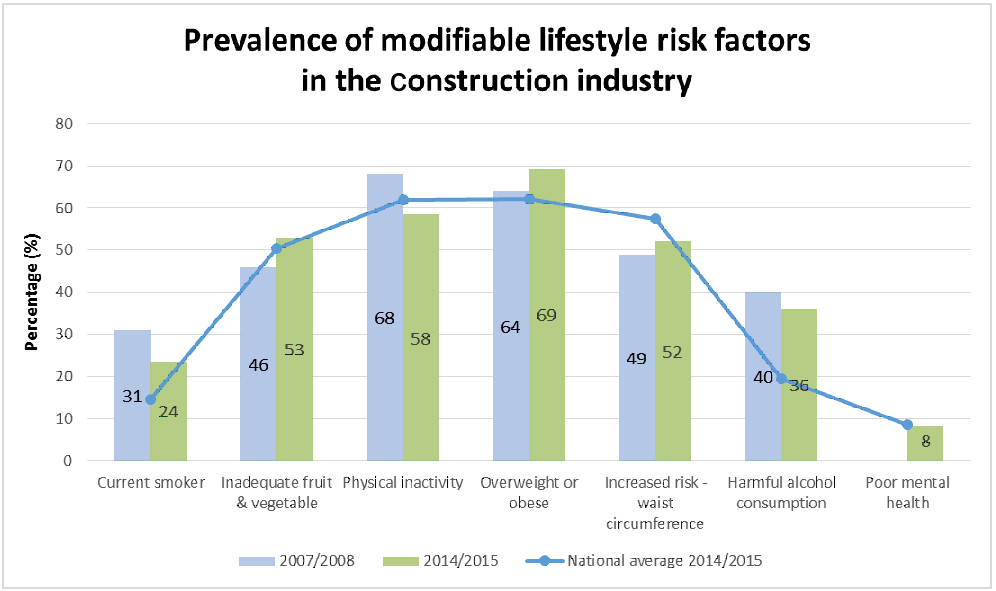
Summary - Workers' Health Challenges in the Construction Industry
Based on the National Health Survey data from 2014-15, the construction industry faces notable health challenges, including high rates of musculoskeletal injury and psychological distress. Approximately 20% of workers reported experiencing stress, depression, or anxiety in the past year. The sector has grown significantly in recent years, constituting 9% of Queensland's workforce and making it the largest industry. However, it also contributes to 10% of workers' compensation claims in the region.
Several industry-specific factors contribute to poor health outcomes:
Male Dominated Workforce: The industry's predominantly male workforce is less inclined to undergo regular medical check-ups, impacting their ability to address physical and mental health issues.
Long Working Hours: Extended work hours have been linked to chronic diseases, with construction workers citing long hours, limited recovery time, and exhaustion hindering engagement in healthy activities and contributing to increased alcohol use.
Transient Workforce: The lack of a centralized workplace makes it challenging to implement health interventions and safety training consistently.
Project-Based Work: The focus on results-based remuneration, narrow profit margins, and tight deadlines often sidelines employee wellbeing, work-life balance, and health pursuits.
The impact of workers' health on safety and business performance is evident in various aspects of the construction supply network. Factors such as fatigue, reduced alertness, and impaired physical and mental functioning contribute to safety hazards, project delays, increased injury rates, and skills shortages. Addressing these health challenges is crucial for sustaining a safe and productive construction industry.
Construction industry references
- Australian Bureau of Statistics. 2014-2015 National Healthy Survey: Prevalence of modifiable risk factor results by industry [Internet]. Canberra (AUST): ABS; 2016. [Cited 2 August 2016]. Available from: http://www.abs.gov.au/australianhealthsurvey
- Safe Work Australia. Construction industry profile [Internet]. Canberra (AUST): SWA; 2015. [Cited 19 August 2016]. Available from: https://www.safeworkaustralia.gov.au/doc/construction-industry-profile
- Australian Bureau of Statistics. Labour Force, Australia, Detailed, Quarterly, Feb 2016, cat. no. 6291.0.55.003 [Internet]. Canberra (AUST): ABS; 2016. [Cited 16 August 2016]. Available from: http://www.abs.gov.au/ausstats/abs@.nsf/mf/6291.0.55.003
- Queensland Government. Industry job trends and statistics. [Internet]. Brisbane (AUST): Queensland Government; 2014. [Cited 19 August 2016]. Available from: https://www.qld.gov.au/jobs/pages/industry.html
- Virtanen M, Heikkila K, Jokela M, Ferrie JE, Batty GD, Vahtera J, Kivimaki M. Long Working Hours and Coronary Heart Disease: A Systematic Review and Meta-Analysis. American Journal of Epidemiology [Internet] 2012; 176(7):586-596. [Cited 19 August 2016]. Available from: http://aje.oxfordjournals.org/content/176/7/586.long
- Viester L, Verhagen E, Bongers P & van der Beek A. The Effect of a Health Promotion Intervention for Construction Workers on Work-related Outcomes: results from a randomized controlled trial. International Archives of Occupational and Environmental Health [Internet] 2014. [Cited 17 August 2016]. Available from: http://link.springer.com/article/10.1007%2Fs00420-014-1007-9
- Lingard, H., Cooke, T. & Blkismas, N. (2011) - Coworkers' response to occupational health and safety: An overlooked dimension of group-level safety climate in the construction industry? Engineering, Construction and Architectural Management, 18 (2), 159-175.
- MacKenzie, S. (2008). A close look at work and life balance/wellbeing in the Victorian commercial building and construction sector Building Industry Consultative Council, Melbourne.
Mining and Resource Industry
The mining and resource industry encompasses a diverse range of supply chain organizations, including manufacturing, construction, transport, storage, retail, mine camp management services, and hospitality services.
Based on the 2014-15 National Health Survey, workers in the mining and resource sector face elevated health risks compared to other industries. Higher rates of smoking, physical inactivity, harmful alcohol consumption, obesity, and inadequate fruit and vegetable consumption were reported among these workers, surpassing national averages. While there have been marginal improvements since 2007-08, such as a reduction in smoking rates, these challenges persist. Addressing these health concerns is crucial for fostering a healthier workforce in the mining and resource industry.
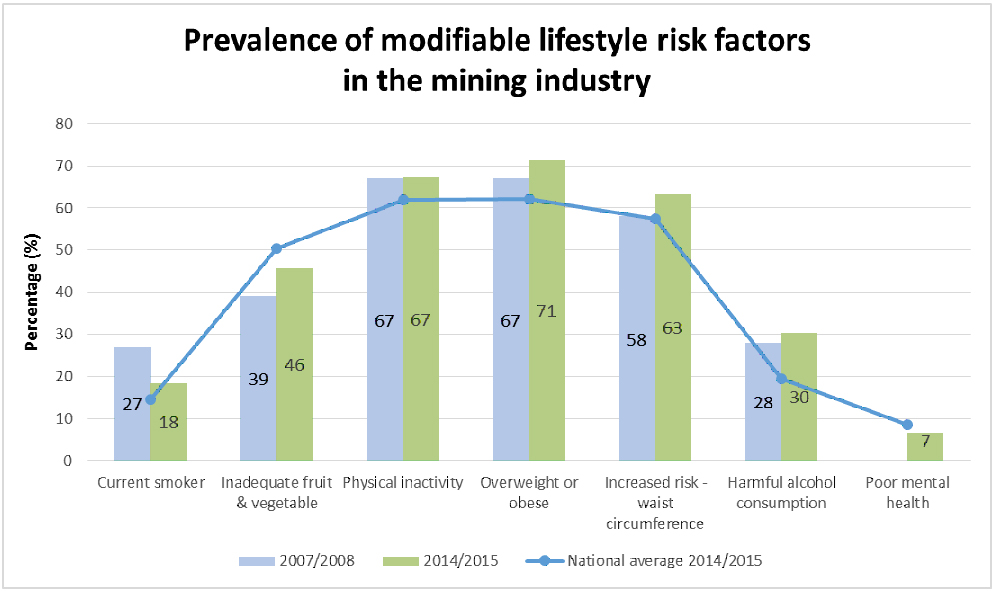
Health Challenges in the Mining and Resources Sector
Based on the National Health Surveys of 2014-15 and 2007-08, workers in Queensland's mining and resources sector face a multitude of health challenges. In addition to common risk factors like smoking, poor nutrition, harmful alcohol consumption, physical inactivity, obesity, and mental health issues, employees in this sector also contend with:
- Fatigue and Psychological Stress: Long working hours and shift work contribute to fatigue, psychological stress, and depression.
- Substance Abuse and Infections: The industry reports issues of substance abuse and an increased risk of sexually transmitted infections.
- Sedentary Work Challenges: Sedentary occupations in the sector pose risks of injuries, overweight, and obesity, potentially leading to chronic diseases and early mortality.
- Fly-In Fly-Out (FIFO) Culture Impact: The FIFO work culture contributes to harmful alcohol consumption and mental health challenges.
- Long Working Hours and Shift Work Risks: Extended work hours and shift work can result in various illnesses such as gastrointestinal and cardiovascular diseases, poor mental health, and weight-related concerns, impacting safety and operational efficiency.
- Accommodation-Related Health Risks: Shared living spaces can foster the transmission of germs, causing illnesses such as colds, flu, gastroenteritis, and skin infections.
The repercussions of poor health extend throughout the resources sector supply network, affecting contractors, sub-contractors, labor hire firms, and project clients. These effects manifest in increased injury rates, workers' compensation premiums, project delays, productivity issues, and skills shortages. Addressing these health challenges is essential for fostering a safer, more productive, and resilient workforce in the mining and resources industry.
Mining and resource industry references
- Australian Bureau of Statistics. 2014/2015 National Healthy Survey: Prevalence of modifiable risk factor results by industry [Internet]. Canberra (AUST): ABS; 2016. [Cited 2 August 2016]. Available from: http://www.abs.gov.au/australianhealthsurvey
- Parliament of Australia. The Australian Resources Sector its contribution to the nation, and a brief review of issues and impacts [Internet]. Canberra (AUST): PA; 2016. [Cited 25 August 2016]. Available from: https://www.aph.gov.au/About_Parliament/Parliamentary_Departments/Parliamentary_Library/pubs/BN/1011/AustResources
- Kinnear S, Kabir A, Mann J, Bricknell L. The need to measure and manage the cumulative impacts of resource development on public health: an Australian perspective, current topics in public health [Internet]. InTech 2013. [Cited 2 September 2016]. Available from: http://www.intechopen.com/books/howtoreference/current-topics-in-public-health/the-need-to-measure-and-manage-the-cumulative-impacts-of-resource-development-on-public-health-an-au
- Education and Health Standing Committee. The impact of FIFO work practices on mental health – final report 2015. Perth: Parliament of Western Australia; 2015.
- Carlisle KN, Parker AW. Psychological distress and pain reporting in Australian coal miners [Internet]. Safety and Health at Work 2014; 5:203-209. [Cited 2 September 2016]. Available from: http://www.e-shaw.net/article/S2093-7911(14)00053-5/abstract
- Vyas MV, Garg AX, Iansavhicus AV, Costella J, Donner A, Laugsand LE, Janskzy I, Mrkobrada M, Parraga G, Hackam DG. Shiftwork and vascular events: systematic review and meta-analysis [Internet]. British Medical Journal 2012; 345. [Cited 25 August 2016]. Available from: http://www.bmj.com/content/345/bmj.e4800
- Proper KI, van de Langenberg D, Rodenburg W, Vermeulen RCH, van der Beek, AJ, van Steeg H, van Kerkhof LWM. The relationship between shift work and metabolic risk factors: a systematic review of longitudinal studies [Internet]. American Journal of Preventative Medicine 2016; 50(5): e147-e157. [Cited 2 September 2016]. Available from: http://www.ajpmonline.org/article/S0749-3797(15)00760-6/abstract
- Caruso C. Negative impacts of shift work and long work hours. Rehabilitation Nursing 2014; 39(1):16-25.
- Centre for Social Responsibility in Mining. Workforce turnover in FIFO mining operations in Australia: an exploratory study - summary report [Internet]. Brisbane (AUST): Sustainable Minerals Institute, UQ; 2013.
- Straker L, Dunstan D, Gilson N, Healy G. Sedentary work – evidence on an emergent work health and safety issue – final report [Internet]. Canberra (AUST): SWA; 2016. [Cited 23 August 2016]. Available from: https://www.safeworkaustralia.gov.au/resources-and-publications/reports/sedentary-work-evidence-emergent-work-health-and-safety-issue
- Wilmot EG, Edwardson CL, Ahana FA, Davies MJ, Gorely T, Gray LJ, Khunti K, Yates T, Biddle SJH. Sedentary time in adults and the association with diabetes, cardiovascular disease and death: systematic review and meta-analysis [Internet] 2012; 55:2895-2905. [Cited 23 August 2016]. Available from: http://dx.doi.org/10.1007/s00125-012-2677-z
- Scholtz J, Nieuwoudt R. Medical services in Moranbah and the impact of non-residential workers, submission to the House of Representatives Standard Committee on Regional Australia, Inquiry into the use of 'fly-in, fly-out' (FIFO) workforce practices in regional Australia [Internet]. Moranbah (AUST): Moranbah Medical; 2011. [Cited 25 August].
- Dong XS, Wang W, Largay JA. Occupational and non-occupational factors associated with work-related injuries among construction workers in the USA [Internet]. International Journal of Occupational and Environmental Health 2015; 37(1):142-150. [Cited 23 August 2016]. Available from: https://www.researchgate.net/publication/274259766_Occupational_and_non-occupational_factors_associated_with_workrelated_injuries_among_construction_workers_in_the_USA
- Casimirri E, Vaccari A, Schito M, Bonci M, Stendardo M, Stefanati A, Nardini M, Boschetto P. Chronic diseases are strongly associated with sickness absences in a sample of Italian public employees [Internet]. International Journal of Occupational Medicine & Environmental Health 2014; 27(3):343-354. [Cited 23 August 2016]. Available from: http://link.springer.com/article/10.2478/s13382-014-0256-x?no-access=true
- Van Nuys K, Globe D, Ng-Mak D, Cheung H, Sullivan J, Goldman D. The association between obesity and employer costs: evidence from a panel of U.S. employers [Internet]. American Journal of Health Promotion 2014; 28(5)277-285. [Cited 2 September 2016]. Available from: http://www.ajhpcontents.com/doi/full/10.4278/ajhp.120905-QUAN-428
Public Service Industry
In the public service industry, workers encounter risk factors for chronic diseases that align with those of the general population. Rates of overweight or obesity, as well as waist circumference, surpass the national average. However, positive trends have emerged since 2007-08, including a decline in smoking rates, an increase in physical activity levels, and a reduction in harmful alcohol consumption. These improvements suggest a positive shift in the health behaviors of public service workers, contributing to a healthier workforce.
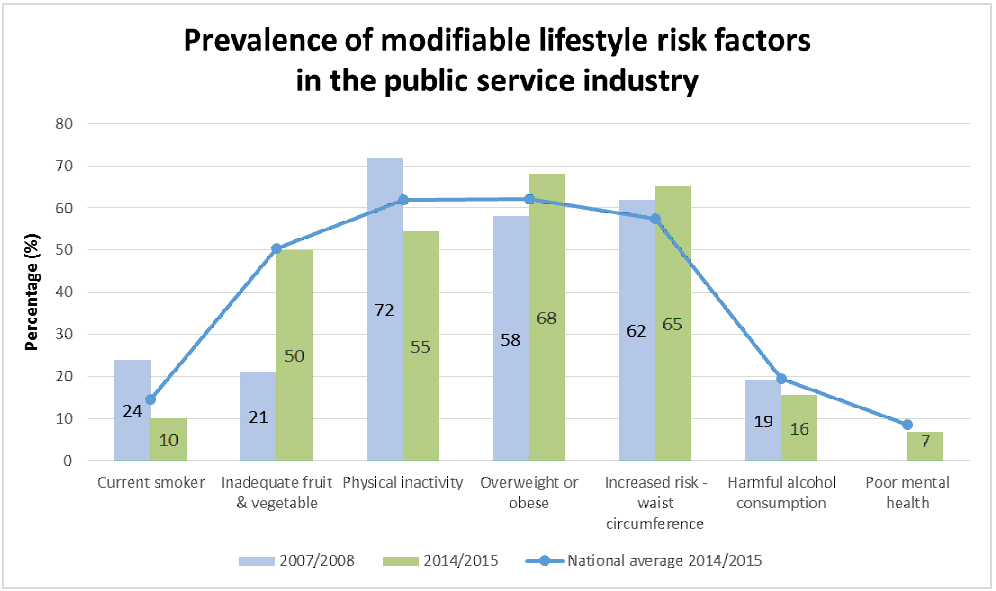
National Healthy Survey 2014-15 and 2007-08: Prevalence of modifiable risk factor results for the construction industry.1 Note: Poor mental health was not measured in 2007-08 National Health Survey.
Industry Health Factors in Queensland Public Service
The Queensland Public Service (QPS) grapples with health challenges influenced by its ageing workforce, where a significant portion is aged 50 or older, a demographic prone to higher illness rates. Sedentary job roles, prevalent in the QPS, pose health risks, as evidenced by emerging data associating prolonged sedentary behavior with chronic diseases, regardless of individual physical activity levels. The impact of worker health on safety and business performance is evident in reduced productivity, increased injury risks, and elevated costs due to absenteeism and presenteeism. Overweight and obese workers face higher disability rates and increased sick days, injuries, and workers' compensation claims. Addressing these health issues is crucial for fostering a more productive and thriving workforce within the QPS.
Public service industry references
- Australian Bureau of Statistics. 2014/2015 National Healthy Survey: Prevalence of modifiable risk factor results by industry [Internet]. Canberra (AUST): ABS; 2016. [Cited 2 August 2016]. Available from: http://www.abs.gov.au/australianhealthsurvey
- Public Service Commission. Queensland public sector quarterly workforce profile 2016 [Internet]. Brisbane (AUST): State of Queensland; 2016. [Cited 23 August 2016].
- Straker L, Dunstan D, Gilson N, Healy G. Sedentary work – evidence on an emergent work health and safety issue – final report [Internet]. Canberra (AUST): SWA' 2016. [Cited 23 August 2016]. Available from: https://www.safeworkaustralia.gov.au/resources-and-publications/reports/sedentary-work-evidence-emergent-work-health-and-safety-issue
- Wilmot EG, Edwardson CL, Ahana FA, Davies MJ, Gorely T, Gray LJ, Khunti K, Yates T, Biddle SJH. Sedentary time in adults and the association with diabetes, cardiovascular disease and death: systematic review and meta-analysis [Internet] 2012; 55:2895-2905. [Cited 23 August 2016]. Available from: http://dx.doi.org/10.1007/s00125-012-2677-z
- Lehnert T, Sonntag K, Konnopka A, Riedel-Heller S, Konig HH. Economic costs of overweight and obesity [Internet]. Best Practice & Research Clinical Endocrinology & Metabolism 2013; 27:105-115. [Cited 5 September 2016]. Available from: http://www.sciencedirect.com/science/article/pii/S1521690X1300016X
Agriculture Industry Health Status
Individuals in outer regional, rural, and remote areas, particularly in the agriculture industry, exhibit a higher likelihood of engaging in high-risk behaviors compared to those in major cities and inner regional areas. Encouragingly, since 2007-08, there has been a decrease in smoking rates and harmful alcohol consumption within this demographic, indicating positive shifts in health-related behaviors.
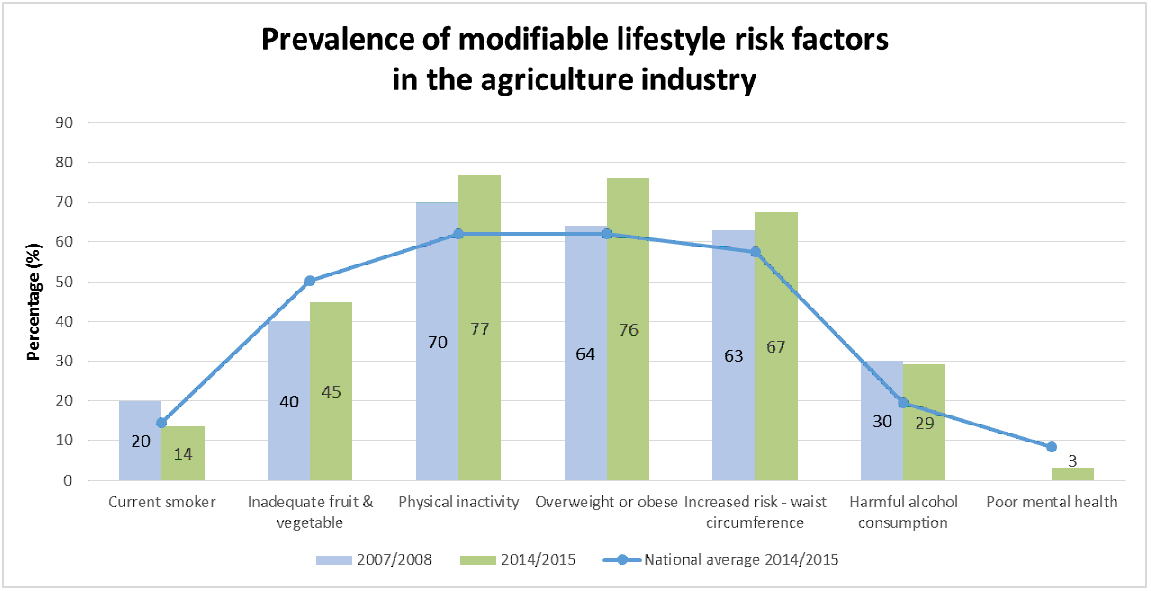
Agriculture Industry Health Status
In the agriculture industry, particularly among male farmers and farm managers, there are elevated death rates from coronary artery disease, certain cancers, respiratory diseases, and mental health issues compared to the average Australian male aged 25 to 74.
The 2013 National Drug Strategy Household Survey highlights increased harmful alcohol consumption and smoking in rural areas, with higher rates among men, youths, and those in farming. Factors contributing to poor health include physically hazardous occupations, reduced physical activity due to agricultural innovation, environmental challenges, limited access to healthy resources, and challenges in seeking health assistance in rural areas. The impact on safety and business performance includes heightened risks of injuries, incidents, lower productivity, chronic diseases, and mental health issues.
Agriculture industry references
- Australian Bureau of Statistics. 2014/2015 National Healthy Survey: Prevalence of modifiable risk factor results by industry [Internet]. Canberra (AUST): ABS; 2016. [Cited 2 August 2016]. Available from: http://www.abs.gov.au/australianhealthsurvey
- Australian Institute of Health and Welfare. A snapshot of men's health in regional and remote Australia. Rural health series no. 11. Cat. No. PHE 120 [Internet]. Canberra (AUST): AIHW; 2010. [Cited 23 August 2016]. Available from: http://www.aihw.gov.au/publication-detail/?id=6442468343
- AIHW. National Drug Strategy Household Survey detailed report: 2013. Drug statistics series no. 28. Cat. No. PHE 183 [Internet]. Canberra: AIHW; 2014. [Cited 23 August 2016. Available from: http://www.aihw.gov.au/publication-detail/?id=60129549469
- Brumby S, Chandrasekara A, Kremer P, Lewandowski P. Cardiovascular risk factors and pshychological distress in Australian farming communities. Australian Journal of Rural Health 2012; 20:131-137.
- Brumby S, Kennedy A, Chandrasekara A. Alcohol consumption, obesity, and psychological distress in farming communities – an Australian study. The Journal of Rural Health 2013; 29:311-319.
- Australian Bureau of Statistics 2012. 4102.0 Australian Social Trends [Internet]. Canberra (AUST): ABS; 2012. [Cited 23 August 2016]. Available from: http://www.abs.gov.au/AUSSTATS/abs@.nsf/allprimarymainfeatures/EED42391CD269634CA257B4800143EAC
- Safe Work Australia. The Australian workplace barometer: report on psychosocial safety climate and worker health in Australia [Internet]. Canberra (AUST): SWA; 2012. [Cited 23 August 2016]. Available from: https://www.safeworkaustralia.gov.au/resources-and-publications/reports/australian-workplace-barometer-report-psychosocial-safety-climate-and-worker-health-australia
- Leka S & Jain A. Health impact of the psychosocial hazards of work: an overview. Geneva (CHE): WHO; 2010.
- Straker L, Dunstan D, Gilson N, Healy G. Sedentary work – evidence on an emergent work health and safety issue – final report [Internet]. Canberra (AUST): SWA' 2016. [Cited 23 August 2016]. Available from: https://www.safeworkaustralia.gov.au/resources-and-publications/reports/sedentary-work-evidence-emergent-work-health-and-safety-issue
Transport Industry Health Status
A survey by the Department of Health and Ageing indicates that all modifiable risk factors in the transport industry surpass the national average. While smoking rates have decreased since 2007-08, physical activity levels and the consumption of adequate fruit and vegetables have shown improvement.
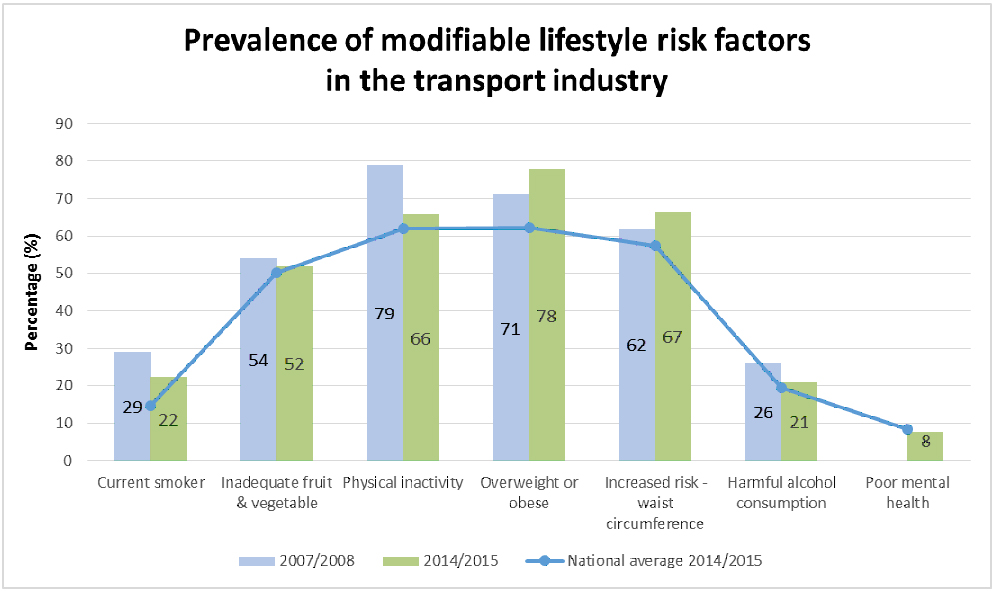
Transport Industry Health Status
The transport industry exhibits an elevated prevalence of modifiable risk factors, with an ageing workforce comprising 46% of individuals over 45 years. This demographic trend poses higher injury and illness risks. Undiagnosed medical conditions, such as heart disease and sleep disorders, heighten the likelihood of vehicle incidents.
Key Factors Contributing to Poor Health:
- Nature of Work: Transport drivers' workplace is predominantly their vehicle, involving sedentary work with intermittent physical activity during loading and unloading.
- Working Conditions: Long and irregular working hours, solitary periods, and performance-based wage structures contribute to time pressures and tight deadlines.
- Industry Emphasis: Historically, the industry focused on 'fit for work' rather than holistic health, necessitating the integration of effective health interventions for a healthier workplace.
Impact on Safety and Business Performance:
- Health Effects: Poor health correlates with increased injury rates, higher workers' compensation premiums, and productivity and skills shortages.
- Specific Health Risks:
- Sleep apnea, linked to obesity, heightens fatigue and accident risks.
- Sedentary behavior associates with cardiovascular diseases, type 2 diabetes, psychological distress, and certain cancers.
- Long working hours contribute to depression, fatigue, musculoskeletal disorders, and other health issues.
- Financial Implications: Addressing the challenges posed by an ageing workforce and rising chronic diseases is crucial for retention, as replacing a worker may cost up to 150% of the driver's annual salary.
In conclusion, prioritizing comprehensive health and wellbeing interventions is imperative for creating a safer and more sustainable environment in the transport industry.
Transport industry references
- Australian Bureau of Statistics. 2014/2015 National Healthy Survey: Prevalence of modifiable risk factor results by industry [Internet]. Canberra (AUST): ABS; 2016. [Cited 2 August 2016]. Available from: http://www.abs.gov.au/australianhealthsurvey
- Apostolopoulos Y, Sönmez S, Shattell M, Haldeman L, Strack R, Jones V. - Barriers to truck drivers' healthy eating: Environmental influences and health promotion strategies [Internet]. Journal of Workplace Behavioral Health 2011; 26(2):122–143. [Cited 23 August 2016]. Available from: http://www.tandfonline.com/doi/full/10.1080/15555240.2011.573754
- Apostolopoulos Y, Sönmez S, Shattell MM, Belzer M. Worksite-induced morbidities among truck drivers in the United States [Internet]. AAOHN Journal: Official Journal of the American Association of Occupational Health Nurses 2010; 58(7):285–296. [Cited 23 August 2016]. Available from: http://whs.sagepub.com/content/58/7/285.long
- Ng MK, Yousuf B, Bigelow PL, Van Eerd D. Effectiveness of health promotion programmes for truck drivers: a systematic review [Internet]. Health Education Journal 2015; 74(3):270-286. [Cited 23 August 2016]. Available from: http://hej.sagepub.com/content/74/3/270.full.pdf+html
- Australian Rotary Health Research Fund. Health Survey of the NSW Transport Industry. 2008Safework https://www.safeworkaustralia.gov.au/resources-and-publications/fact-sheets/transport-and-storage-fact-sheet
- Australian Bureau of Statistics. Labour Force, Australia, Detailed, Quarterly, Feb 2016, cat. no. 6291.0.55.003. Canberra (AUST): ABS; 2016. Available from: http://www.abs.gov.au/ausstats/abs@.nsf/mf/6291.0.55.003
- Sharwood LN, Elkington J, Stevenson M, Grunstein RR, Meuleners L, Ivers RQ, Haworth N, Norton R, Wong KK. Assessing sleepiness and sleep disorders in Australian long-distance commercial vehicle drivers: self-report versus an “at home” monitoring device [Internet]. SLEEP 2012; 35(4):469-475. [Cited 18 August 2016]. Available from: https://academic.oup.com/sleep/article/35/4/469/2558854
- Straker L, Dunstan D, Gilson N, Healy G. Sedentary work – evidence on an emergent work health and safety issue – final report [Internet]. Canberra (AUST): SWA' 2016. [Cited 23 August 2016]. Available from: https://www.safeworkaustralia.gov.au/resources-and-publications/reports/sedentary-work-evidence-emergent-work-health-and-safety-issue
- Virtanen M, Heikkila K, Jokela M, Ferrie JE, Batty GD, Vahtera J, Kivimaki M. Long Working Hours and Coronary Heart Disease: A Systematic Review and Meta-Analysis. American Journal of Epidemiology [Internet] 2012; 176(7):586-596. [Cited 19 August 2016]. Available from: http://aje.oxfordjournals.org/content/176/7/586.long
- Lim S et al. A comparative risk assessment of burden of disease and injury attributable to 67 risk factors and risk factor clusters in 21 regions, 1990–2010: a systematic analysis for the Global Burden of Disease Study 2010 [Internet]. The Lancet 2012; 380: 2224-2260. [Cited 5 September 2016]. Available from: http://www.sciencedirect.com/science/article/pii/S0140673612617668
- Van Nuys K, Globe D, Ng-Mak D, Cheung H, Sullivan J, Goldman D. The association between obesity and employer costs: evidence from a panel of U.S. employers [Internet]. American Journal of Health Promotion 2014; 28(5)277-285. [Cited 2 September 2016]. Available from: http://www.ajhpcontents.com/doi/full/10.4278/ajhp.120905-QUAN-428
- Lehnert T, Sonntag K, Konnopka A, Riedel-Heller S, Konig HH. Economic costs of overweight and obesity [Internet]. Best Practice & Research Clinical Endocrinology & Metabolism 2013; 27:105-115. [Cited 5 September 2016]. Available from: http://www.sciencedirect.com/science/article/pii/S1521690X1300016X
- Australian Government Comcare. Benefits to business: the evidence for investing in worker health and wellbeing. Canberra (AUST): Comcare; 2014. Available from: http://www.comcare.gov.au/Forms_and_Publications/publications/services/safety_and_prevention/safety_and_prevention/bene_to_busin_the_evid_for_invest_in_work_health_wellbeing
- National Transport Commission and Michael Quinlan. 2008. Safe Payments: Addressing the Underlying Causes of Unsafe Practices in the Road Transport Industry. Melbourne: National Transport Commission.
Manufacturing Industry
the health condition within the manufacturing industry is a matter of concern. This industry encompasses various sectors such as food and beverage production, clothing and textiles, furniture, wood and paper production, chemical and pharmaceutical production, as well as transport and machinery production.
According to a survey conducted by the Department of Health and Ageing, the manufacturing industry exhibits higher-than-average rates for all modifiable risk factors. Despite some positive trends such as a decline in smoking rates since 2007-08, increased physical activity levels, and reduced consumption of harmful alcohol levels, the overall health status remains a notable issue for workers in this diverse sector.
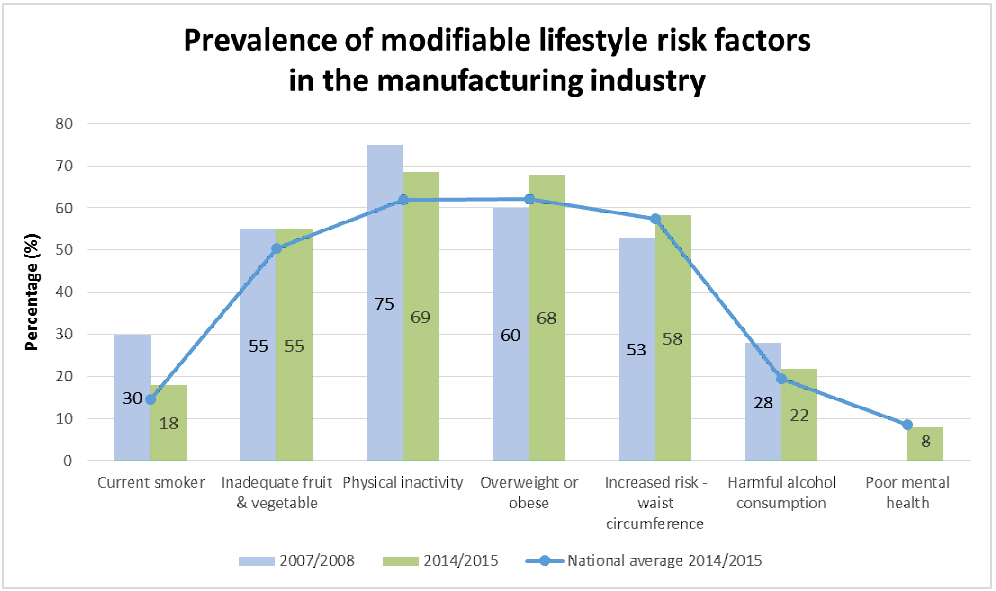
The National Health Survey conducted in 2014-15 compared to 2007-08 highlights the prevalence of modifiable risk factors in the construction industry. It's worth noting that poor mental health was not measured in the 2007-08 survey. In addition to this, workers in the manufacturing industry face exposure to various occupational hazards such as airborne particulates, noise, chemicals, and vibration. Musculoskeletal injuries account for 45% of all claims in this sector.
Various industry factors contribute to poor health. Shift work, irregular hours, the sedentary nature of the work, and difficulties accessing healthy food are identified as contributors to health issues. In the manufacturing sector, long working hours, increased workloads during holidays, exposure to dangerous machinery, repetitive movements, heavy lifting, and hazardous chemicals further pose risks to workers.
The industry, characterized by an aging workforce with a significant male majority, faces challenges such as a higher rate of injury and illness among older workers, with males being less likely to seek medical assistance. Performance-based wage structures and casual employment patterns also discourage taking leave for sickness or holidays.
The impact of worker health and well-being on safety and business performance is significant. High job demands increase the risk of safety shortcuts and fatigue, leading to incidents or injuries. Long working hours and shift work are associated with various health issues, including depression, fatigue, type 2 diabetes, musculoskeletal disorders, gastrointestinal disorders, cardiovascular disease, and certain cancers, particularly for those with co-morbidities. Chronic diseases, type 2 diabetes, and depression increase the risk of workplace injuries in the manufacturing industry. Fatigue, linked to poor diet, inadequate physical activity, and increased alcohol consumption, impairs both physical and mental functioning, lowering worker safety and productivity and increasing presenteeism.
Evidence indicates that workers averaging three to four hours of overtime a day are around 1.8 times more likely to develop certain chronic diseases. Sedentary behavior is associated with cardiovascular disease, type 2 diabetes, higher waist circumference, psychological distress, and some cancers, highlighting the multifaceted impact of work-related factors on worker health.
Manufacturing industry references
- Safe Work Australia. Work health and safety perceptions: Manufacturing industry [Internet]. Canberra (AUST): SWA; 2015. [Cited 16 August 2016] - Available from: http://www.healthandsafetyhandbook.com.au/report-health-and-safety-perceptions-in-the-manufacturing-industry/
- WorkSafe Queensland. Manufacturing industry –about manufacturing [Internet]. Brisbane (AUST): WSA; 2016. [Cited 16 August 2016]. Available from: https://www.worksafe.qld.gov.au/manufacturing
- SafeWork Australia. Statistics on work-related musculoskeletal disorders [Internet]. Canberra (AUST): SWA;2016. Available from: https://www.safeworkaustralia.gov.au/resources-and-publications/statistical-reports/statistics-work-related-musculoskeletal-disorders
- Australian Bureau of Statistics. Labour Force, Australia, Detailed, Quarterly, Feb 2016. Cat. No. 6291.0.55.003. [Internet]. Canberra: ABS; 2016. [Cited 16 August 2016]. Available from: http://www.abs.gov.au/ausstats/abs@.nsf/mf/6291.0.55.003
- Kubo J, Goldstein BA, Cantley LF, Tessier-Sherman B, Galusha D, Slade MD, Chu IM, Cullen MR. Contribution of health status and prevalent chronic disease to individual risk for workplace injury in the manufacturing environment. Occupational and Environmental Medicine [Internet] 2014; 71:159:166. [Cited 16 August 2016]. Available from: http://oem.bmj.com/content/early/2013/10/16/oemed-2013-101653.full
- Caruso C. Negative impacts of shift work and long work hours. Rehabilitation Nursing 2014; 39(1):16-25.
- Dorrian J, Skinner N, Pisaniello. Work quality, not just quantity: work related predictors of psychological distress, work-family interaction and alcohol consumption [Internet]. Adelaide (AUST): Adelaide Centre for Work and Life; 2010. [Cited 16 August 2016]. Available from: http://www.unisa.edu.au/hawkeinstitute/cwl/default.asp
- Virtanen M, Heikkila K, Jokela M, Ferrie JE, Batty GD, Vahtera J, Kivimaki M. Long Working Hours and Coronary Heart Disease: A Systematic Review and Meta-Analysis. American Journal of Epidemiology [Internet] 2012; 176(7):586-596. [Cited 19 August 2016]. Available from: http://aje.oxfordjournals.org/content/176/7/586.long
- Straker L, Dunstan D, Gilson N, Healy G. Sedentary work – evidence on an emergent work health and safety issue – final report [Internet]. Canberra (AUST): SWA' 2016. [Cited 23 August 2016]. Available from: https://www.safeworkaustralia.gov.au/resources-and-publications/reports/sedentary-work-evidence-emergent-work-health-and-safety-issue
Social Assistance Industry
The health care and social assistance industry encompasses various sectors such as hospital and medical services, mental health, allied health, aged and residential care, child care, and social assistance services. A comparison of health care and social assistance workers' health with the broader Australian adult population reveals higher-than-national averages for physical inactivity and waist circumference. Despite these concerns, positive trends have been observed since 2007-08, including a decline in smoking rates, an increase in physical activity levels, and a reduction in harmful alcohol consumption within the industry.
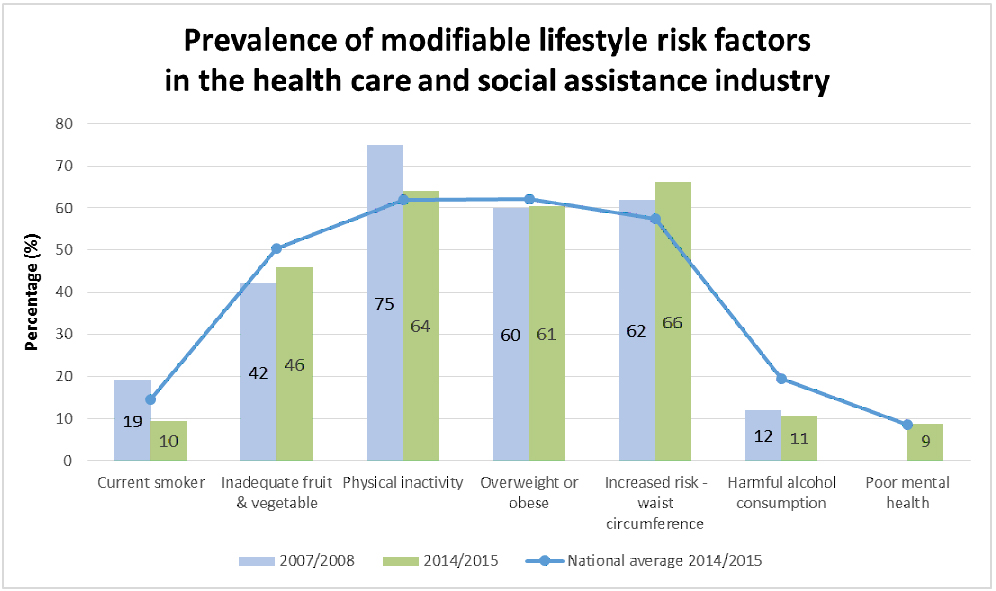
The health care and social assistance industry face significant challenges, with workers experiencing high rates of musculoskeletal injury, sleep disorders, and psychological distress. Employment in this sector has grown by 64% in the last decade, making it the largest industry in Queensland, contributing to 12% of the state's workforce. However, it also accounts for 15% of workers' compensation claims and has more serious injury claims than any other industry. The workforce, which often involves long hours and shift work, faces health issues such as depression, fatigue, type 2 diabetes, musculoskeletal disorders, gastrointestinal disorders, cardiovascular disease, and some cancers.
Workers in this industry, particularly those over 45 years old, are prone to chronic diseases and musculoskeletal injuries, leading to longer recovery times. Additionally, they are more likely to experience bullying, emotional abuse, and violent events, contributing to psychological distress. Shift work and long hours adversely affect physical and mental health, job performance, and workplace productivity, while work-related stress can result in cardiovascular disease, musculoskeletal disorders, gastrointestinal disorders, metabolic syndrome, and type 2 diabetes.
Small businesses, constituting almost half of the Queensland workforce, face unique challenges. They often operate with fewer resources, leading to a lower likelihood of prioritizing health, safety, and well-being practices compared to larger businesses. Small business owners and workers have a higher prevalence of risk factors for chronic diseases, such as being overweight or obese, physically inactive, having low fruit and vegetable intake, smoking, and engaging in harmful alcohol consumption. The organizational structure of small businesses, often involving owner-operators and limited resources, contributes to stress, fatigue, and depression.
Long working hours in small businesses are associated with higher rates of depression, fatigue, type 2 diabetes, musculoskeletal disorders, gastrointestinal disorders, cardiovascular disease, and some cancers. The impact of worker health on safety and business performance in small businesses is significant, with evidence showing that owner/managers experience significant productivity losses due to absenteeism and presenteeism resulting from psychological distress. Work-related stress in small businesses can lead to various health issues, imposing a greater financial burden on these workplaces.
Small business industry references
- Australian Bureau of Statistics. The Australian Health Survey 2014-2015 – first results. Health risk factors by industry [Internet]. Canberra (AUST): ABS; 2016. [Cited 23 August 2016]. Available from: http://www.abs.gov.au/ausstats/abs@.nsf/Lookup/by%20Subject/4364.0.55.001~2014-15~Main%20Features~Key%20findings~1
- Australian Securities and Investments Commission. Small business – what is small business [Internet]. Canberra (AUST): ASIC; 2015. [Cited 23 August 2016]. Available from: http://www.asic.gov.au/for-business/your-business/small-business/small-business-overview/small-business-what-is-small-business/
- Queensland Government. Advancing Small Business Queensland [Internet]. Brisbane (AUST): The State of Queensland; 2016. [Cited 24 November 2016]. Available from: https://www.dtesb.qld.gov.au/small-business/advancing-small-business-queensland
- Cocker F, Martin A, Scott J, Venn A, Sanderson K. Psychological distress, related work attendance and productivity loss in small-to-medium sized enterprise owner/managers [Internet]. International Journal of Environmental Research and Public Health 2013; 10:5062-5082.
- Park J, Jeong H, Hong S, Park J, Kim D, Kim J, Kim H. Effects of health and safety and problem recognition on small business facility investment [Internet]. Annals of Occupational and Environmental Medicine 2013; 25:26-36. [Cited 23 August 2016]. Available from: https://www.researchgate.net/publication/259958693_Effects_of_health_and_safety_problem_recognition_on_small_business_facility_investment
- Leka S & Jain A. Health impact of the psychosocial hazards of work: an overview. Geneva (CHE): WHO; 2010.
- Caruso C. Negative impacts of shift work and long work hours [Internet]. Rehabilitation Nursing 2014; 39(1):16-25. [Cited 2 September 2016]. Available from: http://onlinelibrary.wiley.com/doi/10.1002/rnj.107/epdf
- Virtanen M, Heikkila K, Jokela M, Ferrie JE, Batty GD, Vahtera J, Kivimaki M. Long Working Hours and Coronary Heart Disease: A Systematic Review and Meta-Analysis. American Journal of Epidemiology [Internet] 2012; 176(7):586-596. [Cited 19 August 2016]. Available from: http://aje.oxfordjournals.org/content/176/7/586.long
Wholesale and Retail Industry
The 2014-15 National Health Survey indicates that retail workers exhibit higher rates of smoking, physical inactivity, and inadequate fruit and vegetable consumption compared to the national average across all industries. However, since 2007-08, there have been slight improvements within the retail sector, with a decrease in smoking rates, an increase in physical activity, improved fruit and vegetable consumption, and reduced levels of harmful alcohol consumption among retail workers.
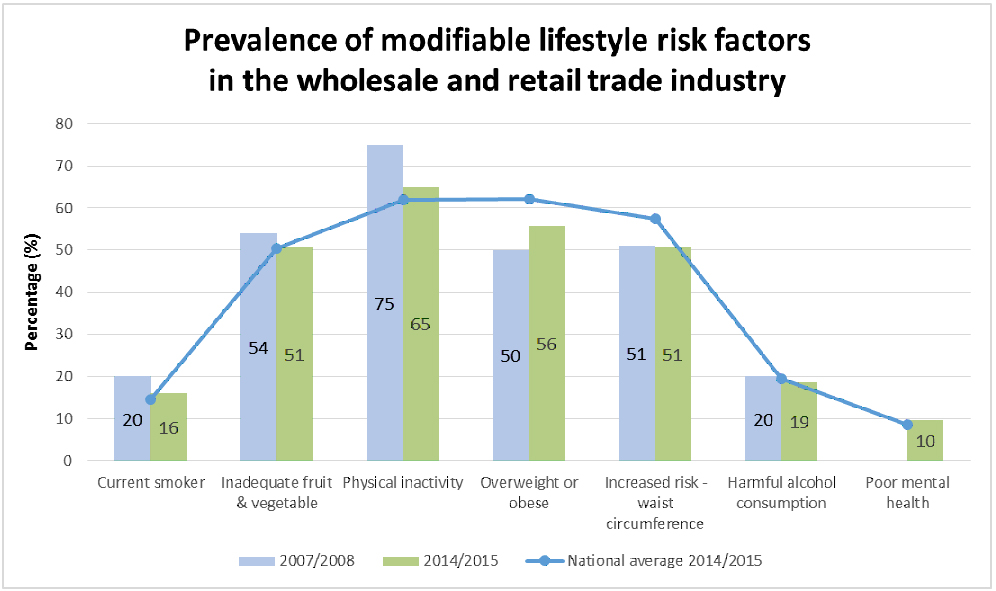
The National Health Survey for the retail trade industry in 2014-15 and 2007-08 revealed prevalent modifiable risk factors, with a note that poor mental health was not measured in the earlier survey. The retail industry, encompassing the purchase and sale of goods to the public, poses specific challenges for well-being:
- Demographics: The retail sector is a significant employer of young people, with those aged 15-24 constituting 40% of the workforce. Additionally, the industry employs older workers transitioning in or out of the workforce, and nearly half of all retail workers work part-time.
- Injury Profile: Sprains and strains account for a third of all injuries in the retail sector.
- Factors Contributing to Poor Health:
- Work Hours and Schedules: Long working hours, irregular schedules, and shift work are common in retail, associated with health issues such as depression, fatigue, type 2 diabetes, musculoskeletal disorders, gastrointestinal disorders, cardiovascular disease, and some cancers. Short breaks, lack of autonomy over schedules, and poor work-life balance contribute to these challenges.
- High Stress Environment: Retail workers often face emotional abuse and aggression from customers, leading to psychological distress.
- Physical Workload: Retail employees are regularly exposed to high physical workloads, repetitive movements, and lifting, contributing to potential injuries and health issues.
- Casual Employment: Many retail workers have casual or temporary employment with lower wages, creating reluctance to take leave for sickness or holidays.
- Impact on Health and Business Performance:
- Irregular work schedules, shift work, long hours, low wages, and a high-stress environment contribute to obesogenic behaviors, fatigue, stress, and depression.
- These factors can lead to injuries, cardiovascular issues, poor work-life balance, sleep disorders, alcohol use, depression, anxiety, and impaired physical and mental functions, lowering worker safety and productivity.
- Smoking behaviors among retail workers pose an additional risk of injury.
In summary, the retail industry's work conditions, demographics, and injury profile indicate challenges to worker well-being, necessitating attention to factors such as
Wholesale and retail references
- Anderson, V.P., et al. Occupational fatalities, injuries, illnesses, and related economic loss in the wholesale and retail trade sector - Am J of Ind Med 2010; 52: 673-685
- Australian Bureau of Statistics. 2014/2015 National Healthy Survey: Prevalence of modifiable risk factor results by industry [Internet]. Canberra (AUST): ABS; 2016. [Cited 2 August 2016]. Available from: http://www.abs.gov.au/australianhealthsurvey
- Carmichael, F. et al. Workplace health and wellbeing in construction and retail: Sector Specific issues and barriers to resolving them. Int J of Workplace Health Management 2016; 9;2: 1-18
- Dong, Z.S., Wantg, Z. & Largay, I.A. (2015)
- Safe Work Australia (2009). - Work-related injuries in Australia, 2005-2016: Retail Industry.
- Strickland, JR et al. Enhancing workplace wellness efforts to reduce obesity: a qualitative study of low-wage workers in St Louis, Missouri, 2013-2014. - Prev Chronic Dis 2015; May 7; 12:E67.
- Strickland, JR et al. Worksite influences on obesogenic behaviours in low-wage workers in St Louis, Missouri, 2013-2014. Prev Chronic Dis 2015; May 7; 12:E66.
- Van Nuys, K., Globe, D., Ng-Mak, D., Cheung, H., Sullivan J & Goldman, D. (2014)
- Virtanen M, Heikkila K, Jokela M, Ferrie JE, Batty GD, Vahtera J, Kivimaki M. Long Working Hours and Coronary Heart Disease: A Systematic Review and Meta-Analysis. American Journal of Epidemiology [Internet] 2012; 176(7):586-596. [Cited 19 August 2016]. Available from: http://aje.oxfordjournals.org/content/176/7/586.long
- Wirtz, A., Narchreiner, D., & Rolfes, K. Working on Sundays-Effects on Safety, Health and Work-Life Balance. Chronobiology International 2017; 28:4: 361-370
